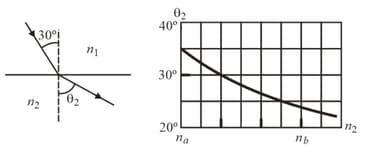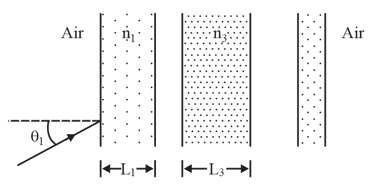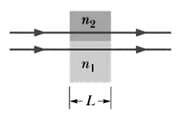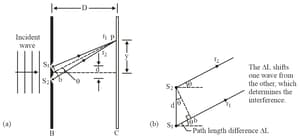A thin film of liquid is held in a horizontal circular ring, with air on both sides of the film. A beam of light at wavelength is directed perpendicularly onto the film, and the intensity of its reflection is monitored. The figure gives intensity as a function of time , the horizontal scale is set by The intensity changes because of evaporation from the two sides of the film. Assume that the film is flat and has parallel sides, a radius of and an index of refraction of Also assume that the film's volume decreases at a constant rate. Find that rate.



Important Questions on Interference
In the figure (a), a beam of light in material is incident on a boundary at an angle of The extent to which the light is bent due to refraction depends, in part, on the index of refraction of material Figure (b) gives the angle of refraction versus for a range of possible values, from to What is the speed of light in material

In the below figure, a light ray is incident at angle on a series of five transparent layers with parallel boundaries. For layers and , , , and .
(a) At what angle does the light emerge back into the air on the right?
(b) How much time does the light take to travel through layer ?

In the following figure, assume that two waves of light in the air, of wavelength , are initially in phase. One travels through a glass layer of the index of refraction and thickness . The other travels through an equally thick plastic layer of the index of refraction .
(a) What smallest value should have if the waves are to end up with a phase difference of ?
(b) If the waves arrive at some common point with the same amplitude, is their interference fully constructive, fully destructive, intermediate, but closer to fully constructive or intermediate but closer to fully destructive?

In the two-slit experiment from the given figure, let angle be , the slit separation be , and the wavelength be .
What multiple of , gives the phase difference between the waves of rays and , on the distant screen?
What is the phase difference in radians?
Determine where, in the interference pattern point lies by giving the maximum or minimum on which it lies, or the maximum and minimum between which it lies.

